Age Of Samurai Battle for Japan Review
By Paul 'Batman' O'Brien
B.A., N.C.E.H.S., Dip. Acu., Adv. Dip. OBB, Cert Clin. Med. Pn1, PN-SSR, PN-NCA, M.AFPA, M.ETCMA, M.C.Th.A.
Okay, a LOT of people have been asking me about an Age Of Samurai Battle for Japan Review. This series was recently released by Netflix to great fanfare and excitement among Samurai fans. Having watched the trailer, I was not overly enthused about the show, but wanted to give it a fair shot and watched it over the weekend making a few notes along what way.
Firstly, here were my initial thoughts based on the trailer, when asked if i thought this would be good.
Age Of Samurai Battle for Japan Review - Will it be Good?
As entertainment, sure, probably this series will probably be good. As historically accurate content...eh no. It will likely not be good. Even in this trailer there are numerous issues. Firstly the prominence of samurai using a katana on the battlefield to kill an opponent. You were more likely to be killed by someone throwing a rock at you than that happening.
Secondly the “Age of Samurai” was very long and encompassed several distinct types of military action and technology. From being fought by rich mounted archers to lowly companies with rifles and spears. To focus on 1 very specific section of about 50 years as this docu-drama suggests and imply that is representative of the “Age of the Samurai” is, well, disingenuous at best.
But this is to be expected given some of the parties involved.
Further thoughts based on a second viewing of the trailer:
- The armour is inaccurate. I am unsurprised given who made it.
- At no point ever did Oda Nobunaga look or act like he does depicted in the trailer.
- Hideyoshi was not a front line killing machine. This is nonsense.
- Masamune was not one of the great unifiers of Japan...at all.
- Samurai combat on a battlefield was not fought with swords like this depicts. Just no.
- Ninja nonsense. They weren't assassins. That wasn't a thing. Stop trying to make fetch happen.
- Stupid, stupid, stupid chiburi/chinigui in the crook of the elbow. That wasn't done.
- Idiot running like an idiot.
- 1550-1600 is not reflective of the "Age of the Samurai".
- Hair is wrong
- Footwear is wrong
- Utterly butchering the pronunciation of some of the names
- Apparently the swords are lightsabers given their ability to easily slice through the armour
- Where are the ashigaru?
- Combat mechanics are not accurate. They are sensationalized nonsense. Which I suspect this will be. Romanticized fantasy. Disappointed.
But, I put all that aside and sat down to watch the Age of Samurai: Battle for Japan review it and make an independent assessment. I was assuming the trailer simply showed the more sensational, entertainment driven aspects of the show to pull in viewers.
20 seconds into the first episode I realized that my initial impressions were sadly, gravely accurate.
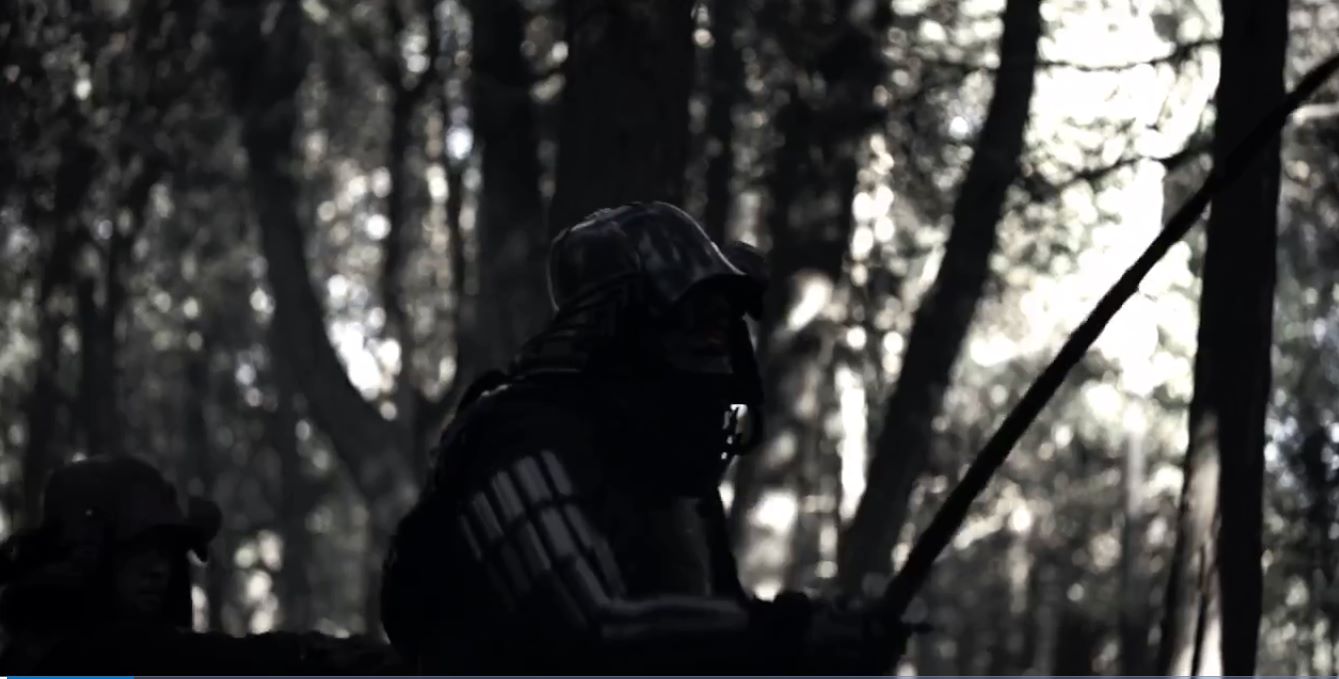 Age of Samurai Battle for Japan Review. A "Samruai" runs towards the opponent with the cutting edge of is sword facing himself.
Age of Samurai Battle for Japan Review. A "Samruai" runs towards the opponent with the cutting edge of is sword facing himself.Behold...20 seconds in, a "samurai" wearing the wrong period armor, carrying the wrong period sword, pulls the sword out with a horrible metal scraping sound (not a thing) and with the sharp edge of the blade facing his own face and runs into battle with the blunt side facing his enemies. Idiot.
Okay...maybe this was a one off.
Literally one second later, 21 seconds into the first episode, they prominently show another incorrectly dressed and equipped samurai doing the exact same thing. Drawing a sword, badly, and keeping the dangerous part of the weapon aimed squarely at their own body.
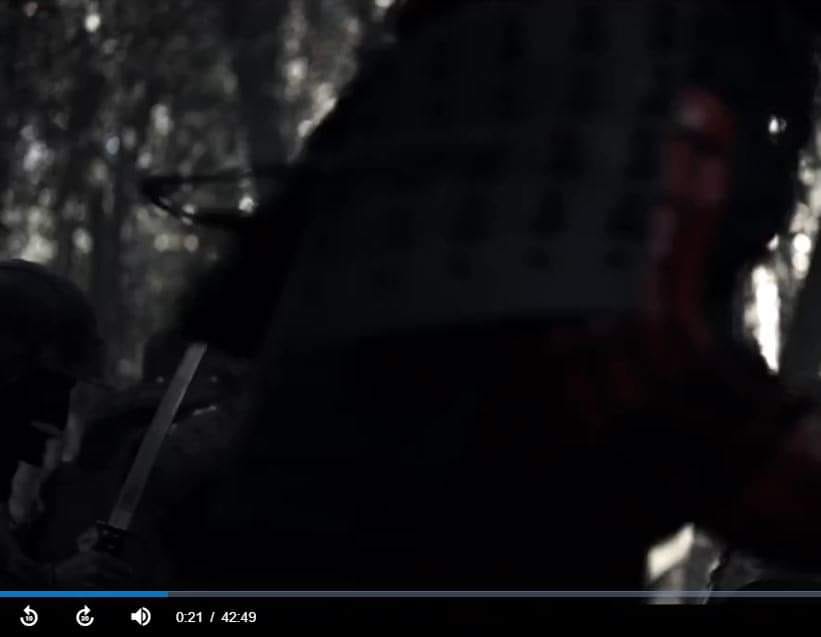 Age of Samurai Battle for Japan Review. Another "Samruai" charges with his sword the wrong way around.
Age of Samurai Battle for Japan Review. Another "Samruai" charges with his sword the wrong way around.These images perfectly encapsulate this series.
The “Age of Samurai” series is split into two distinct sections. Interviews with a number of noted historians, and dramatic “reenactments” of the events as described by these historians.
While I commend the production for taking an interesting approach to the material, trying to balance education and entertainment, I don’t think it works.
You don’t get the excitement of the narrative being told in the reenactments as the pace and momentum, along with any emotional investment in the story, is stalled by the interview interludes. And the interview interludes are utterly undermined by chronically inaccurate and in parts fantastic depictions and wholesale misinterpretation. In trying to do both things they undermine each other, rather than support.
In doing so they took one of the most interesting periods of Japanese military and political history and made it, well kind of boring. There were several moments in each episode where my interest was completely abandoned and my mind wandered. Were it not for an obligation to review the series, I would have quit after the first episode. As it was, I struggled through and found myself having to rewind a few minutes in every episode, and on multiple occasions when I realized my interest had wandered and I was thinking of other things.
Age Of Samurai Battle for Japan Review -Historical Interviews:
The least problematic part of this series were the segments with the historical experts. For the most part they acquitted themselves well, covering a very complicated period of Japanese history in as simple and clear a manner as possible. Was this overly simplified, yes, absolutely, but I think that’s perfectly fine in light of the target demographic and as an introduction more than an academic examination.
However, a problem became apparent shortly after the first episode. In the first episode we see a range of experts, only one of whom is actually Japanese, Kazuhiro Marushima. Over the 6 episodes we hear from this range of historians and authors less and less until we mostly here from just one, Stephen Turnbull, who to be kind about it, is happy to extol and speak more freely about the mythological, fantastical, and dramatic elements than the other experts whose more fact based statements clearly do not serve the narrative the show-runners are trying to tell.
And during this the same old, tired, stereotypes and debunked myths are promoted, and in some cases outright lies. While there are many examples of this in the series from minor (The Samurai were not “the equivalent of the European Knight”, Oda Nobunaga did not swagger into his fathers funeral...he quite notoriously refuse to get off his horse, threw some incense on the altar and rode away, nor was his father cremated) to major (Oda Nobunaga was not the eldest son of Oda Nobuhide. The eldest son was actually Oda Nobuhiro, however Nobuhide disinherited Nobuhiro, claiming he was illegitimate and appointing Nobundaga as his inheritor and eldest “legitimate” son), and they show that Hideyoshi killed Imagawa Yoshimoto! He didn’t. Two Oda samurai named Mōri Shinsuke and Hattori Koheita did. Nor was it accurate to paint Hideyoshi's sword hunt as an authoritarian ransacking. And absolutely no mention of Admiral Yi Sun-sin, who invented the Turtle ship and decimated the Japanese navy, giving Korea the opportunity to beat back Hideyoshi's forces?
To further explain these errors I’ll cite two very obvious examples otherwise I’d have to film my own 6-hour series just to correct the errors!
Age Of Samurai Battle for Japan Review -
Time-Travelling Swords
In the first episode, about 14 minutes in, Turnbull speaks at length about the “katana”. Citing it as “finest sword ever made in world history”, and discusses how it “gave the mounted samurai a huge advantage”. The problem is that - this isn’t the weapon mounted samurai used, nor the weapon widely used by the samurai during the period under discussion at all.
At the time in the docu-drama that Turnbull references the katana as the “samurai’s most iconic weapon” we have been shown battle between 1551 and the murder of Oda Nobuyuki in 1557, by a katana wielding Oda Nobunaga. The problem is the katana they are referring to and depicting did not become prominent until well after Nobunaga’s death. During the period depicted in the reenactment scenes the primary weapon used with the appropriate armour was a tachi or uchigatana (a type of midway point between tachi and katana).
The other issue, one that I’ll cover in more detail later was - the samurai fundamentally did not use the katana on the battlefield anywhere remotely close to the ubiquitous use in the reenactments or as implied by Turnbull. Note, none of the other experts allied to the katana being used in military engagement during the periods under discussion. This is because as I’ll discuss later - it didn’t happen frequently at all. To use a sword on the battlefield was an exception, not the rule.
Age Of Samurai Battle for Japan Review -
Ninja Assassins!
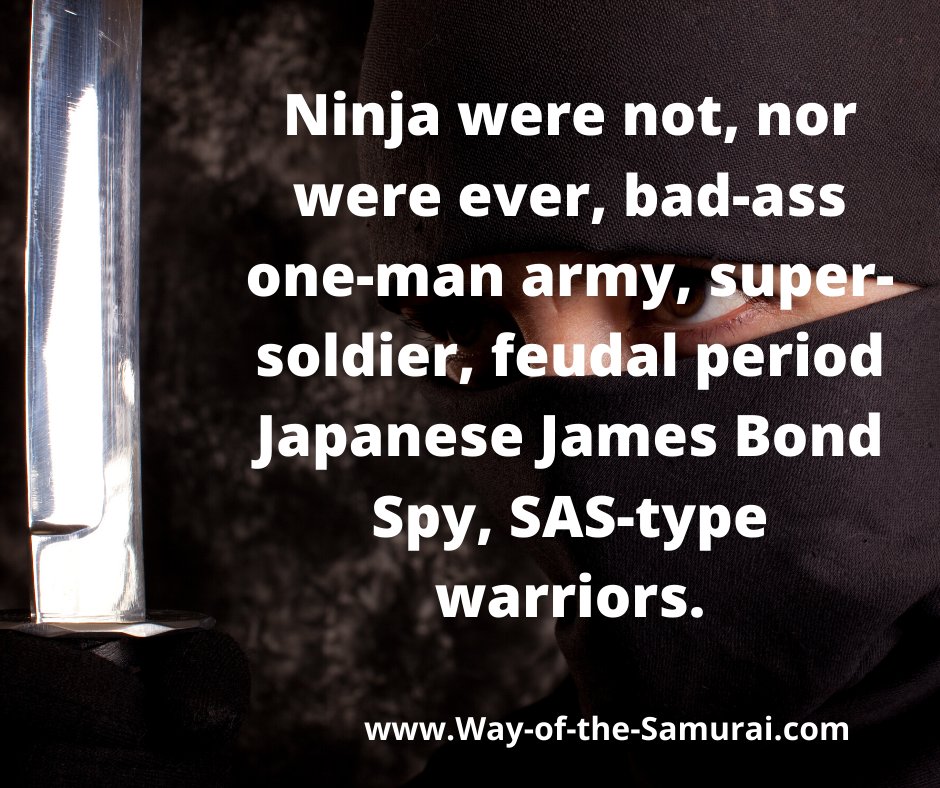
The second primary example of this re-iteration is in Episode 3 where, Darren Ashmore makes statements that we know to be categorically untrue...that
“These people were a mixture of lumbereers and farmers, fisherman and other rugged individuals...a good shinobi can turn their hand to almost anything. Espionage...any form of intelligence gathering...and assassins”.
This is a debunked fairytale, which originates from modern fictional novels such as “Ninja Bugeichō”.
The “lumbereers and farmers, fishermen and other rugged individuals” of Iga did not conduct guerrilla warfare style military operations. The provincial samurai known as Jizamurai, upon whose lands those labourers worked conducted military operations. During that period in Japanese history, peasants in Iga just like everywhere else worked the land owned and controlled by samurai. These samurai lords were only small land holders and could not compete individually with the might of neighboring daimyo such as Oda Nobunaga. As such the smaller Jiszamuria groups would come together to fight off the larger forces using strategy and tactics favored by smaller groups. That’s it.
Further “shinobi no mono” - or “ninja” were little more than local thugs or gossips used to get intelligence. They did not conduct assassinations. Nor were they an elite military force hiding in the mountains, a secret village of feudal Japanese Rambo’s. This is literally fantasy coming from fictional novels. No historian should be repeating these debunked lies. At least Turnbull interjects to explain this is where the “myth of the ninja” comes from. Because the ninja, as described and alluded to here, and as depicted in the reenactments - weren’t real.
The greater issue with the series lies in the “historical reenactments” which are nothing of the kind. Nearly every single aspect of these cutaways and dramatic depictions is wrong. And that is not hyperbole or nitpicking. Genuinely, nearly everything is wrong. And for a historical docu-drama the clear lack of advisor oversight is shocking. Particularly given when they went to the trouble of interviewing educated historians.
There is a LOT to get through in this part so to save some time and my sanity I’m going to group it into a two categories, Cultural and Combative:
Age Of Samurai Battle for Japan Review -
Cultural Errors
As I’ve said nearly everything in these flashbacks is presented incorrectly and it permeates every single level of the show. Here are some quick examples:
Age Of Samurai Battle for Japan Review -
Hair
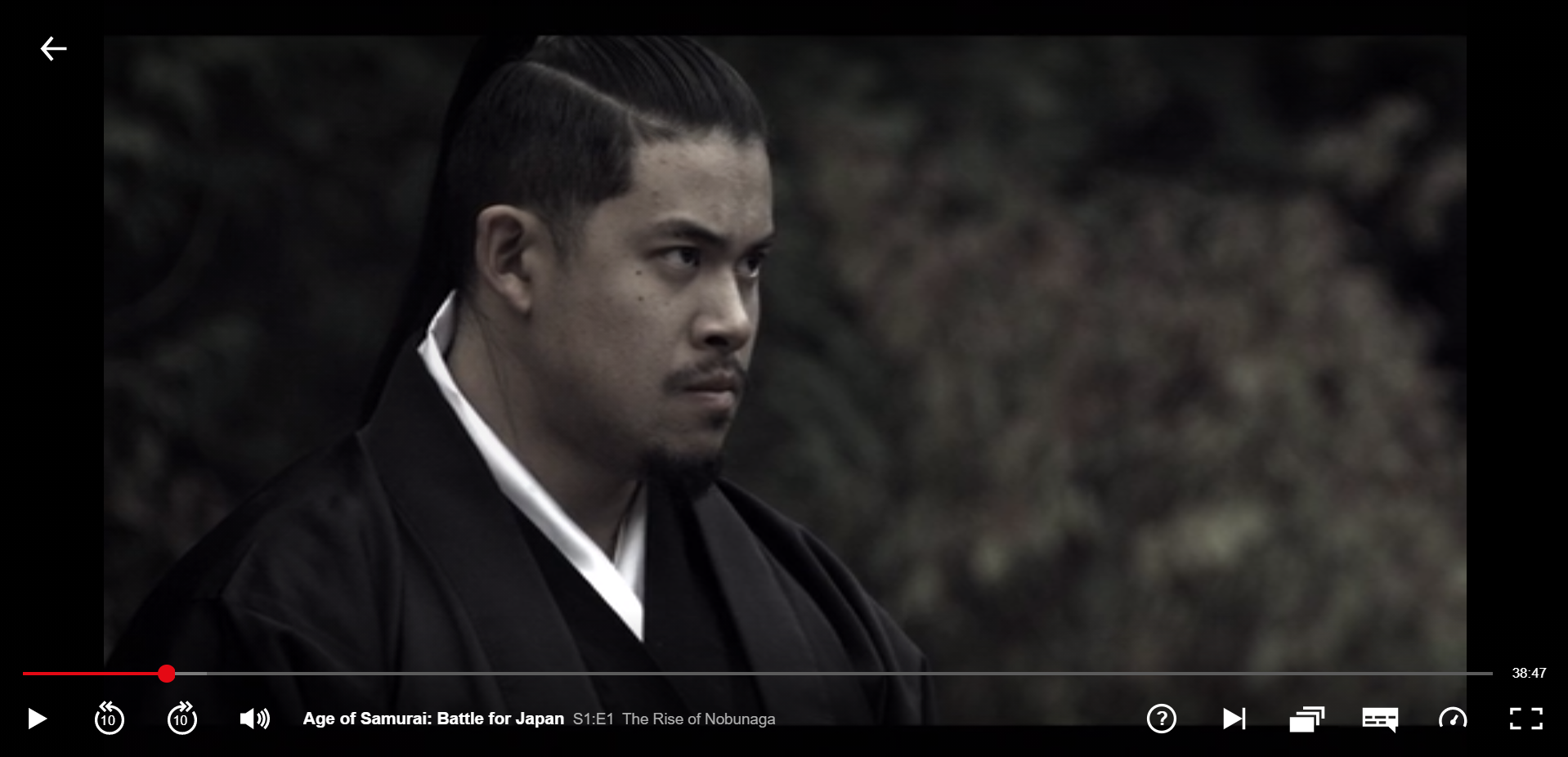 Age of Samurai Battle for Japan Review. Eh...nope
Age of Samurai Battle for Japan Review. Eh...nopeThe hair styles are largely incorrect. I understand they may not want to go to the hassle and budget of getting wigs or styling of correct hairstyles of the day, but no samurai of this period ever wore their hair in a fade and ponytail look. This is just one very visual example of how it was not done. Keep in mind the samurai hairstyle was a signifier of rank/position/social status and carried cultural significance.
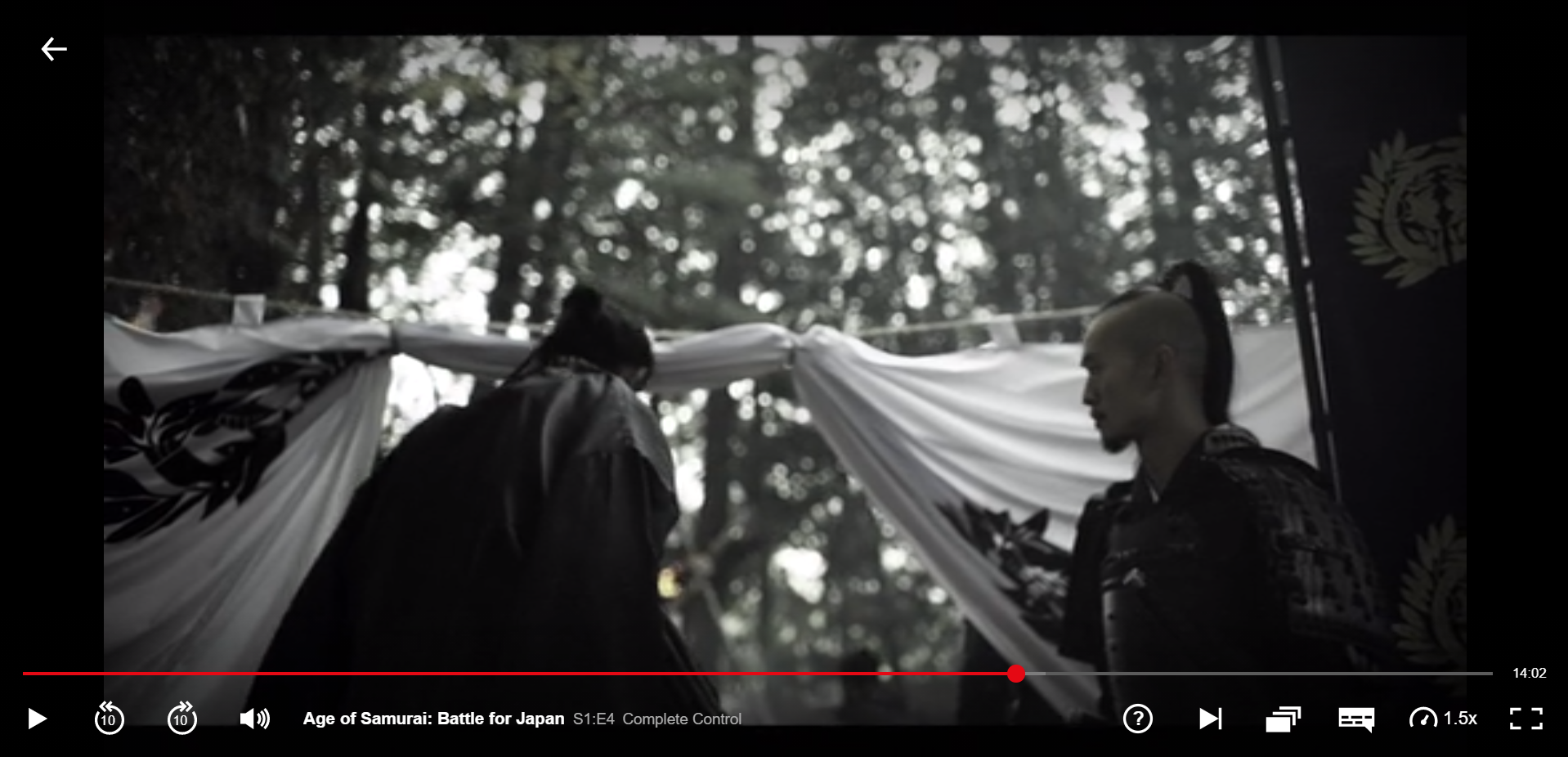 Age of Samurai Battle for Japan Review. Ponytail and Fade. This is more Highlander 3's Kane than history.
Age of Samurai Battle for Japan Review. Ponytail and Fade. This is more Highlander 3's Kane than history.Oda Nobunaga is depicted as having wild unkempt hair. This is totally inaccurate. Accounts of the time and painting show that Nobunaga kept his hair neatly and was in fact noted in his youth for being a tad vain and flamboyant. Favouring the kimono of his mother to swan around and dance as he preferred that sense of elegant refinement. A wild, boorish man with messy hair he absolutely was not.
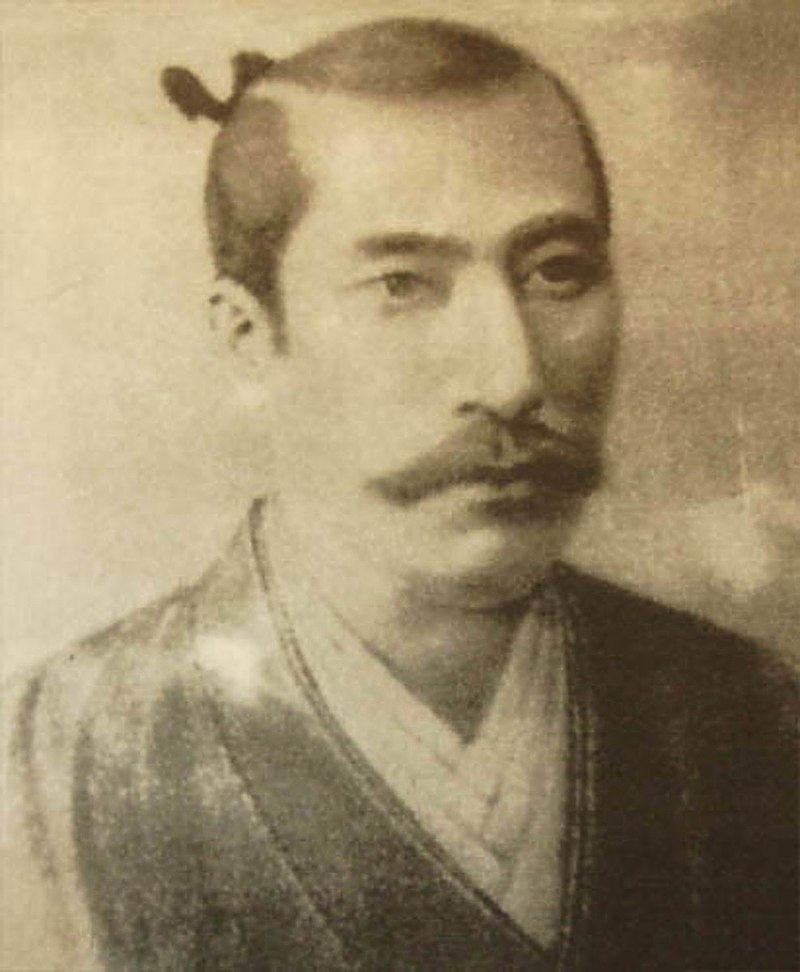 A Portrait of Oda Nobunaga, imagined by Jesuit painter Giovanni Niccolò, 1583–1590.
Not a wild, messy brute
A Portrait of Oda Nobunaga, imagined by Jesuit painter Giovanni Niccolò, 1583–1590.
Not a wild, messy bruteAge Of Samurai Battle for Japan Review -
Clothing
For the large part the clothing is not Japanese, it seems to have more of Korean/Chinese influence. Ashigaru are depicted in later episodes wearing voluminous long sleeved attire they simply wouldn’t have been able to afford. I’ll get to the armour in a bit when discussing combative and military errors...but eh...they don’t know how to wear armour and ashigaru did not wear leather vests with studs like they were Steven Seagal coming out of a 1990’s S&M party. The costume department really dropped the ball on this.
The only clothing I did note that was close to correct were some of the kimonos worn by the women in the series. During 1550-1600 the kimono was different to the modern version we see today. Back then the kimono sleeves were solidly attached (today there is a slit in the underarm connection and more rounded (today's are more large and square. The colour selection was also different today. It was obvious that these were modern kimono but at least a valiant and satisfying effort had been to adjust these modern kimono to better reflect the period shown in the documentary, and they should be commended for this.
Age Of Samurai Battle for Japan Review -
Funerals
Oda Nobuhide, Toyotomi Hideyoshi and Tokugawa Ieyasu were all depicted as being cremated with swords lying upon them. Newsflash. These men were daimyo, incredibly powerful men and the latter two being two of the most powerful men in Japanese history. They were not cremated in the woods. Period.
Age Of Samurai Battle for Japan Review -
Seppuku
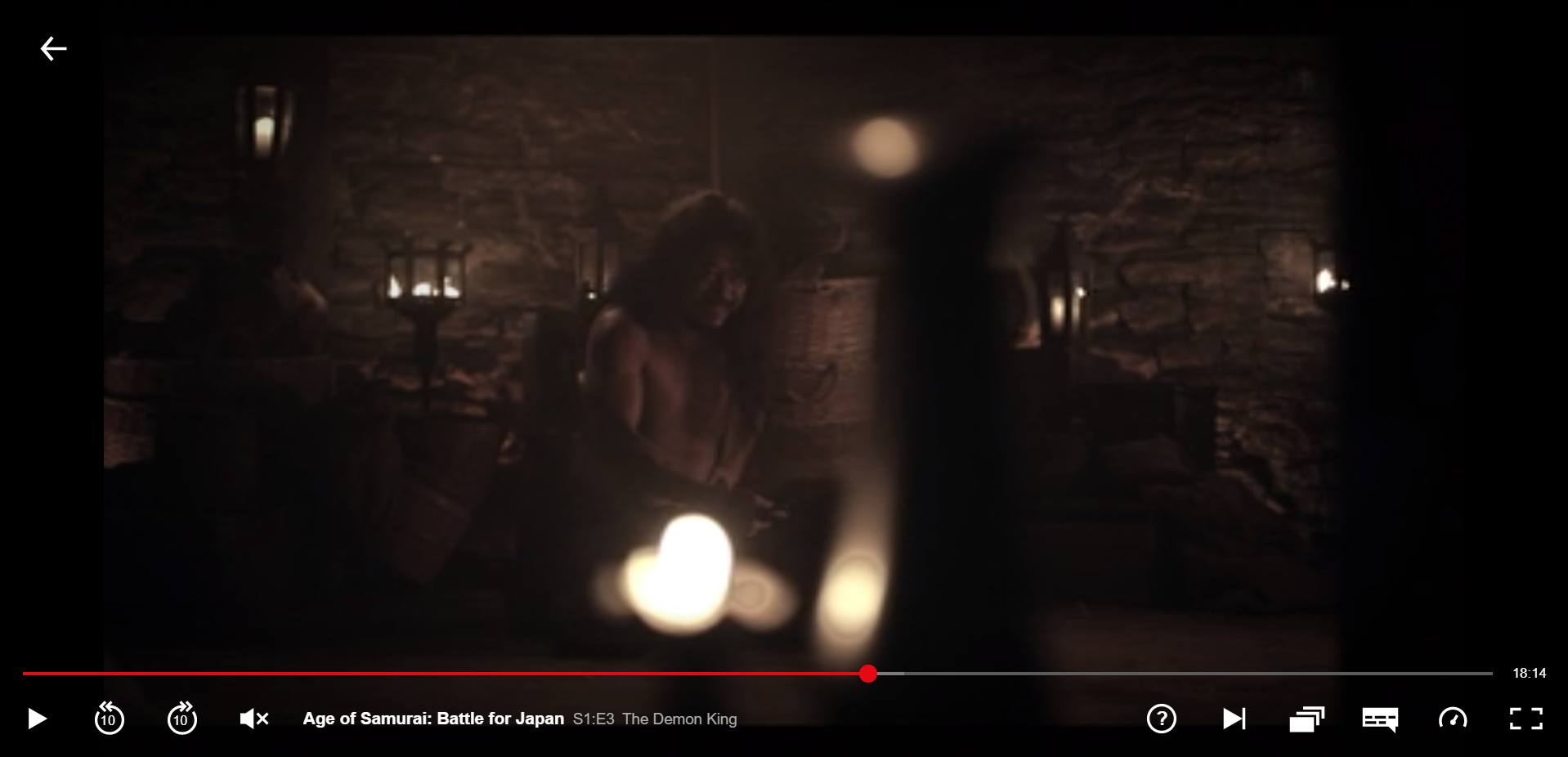 Age Of Samurai: Battle for Japan Review. This is NOT how Sepukku was performed.
Age Of Samurai: Battle for Japan Review. This is NOT how Sepukku was performed.The form of seppuku demonstrated in the series is entirely incorrect. There were specific rituals in performing “kanshi” as depicted in episode 1 by Hirate Masahide and by Oda Nobunaga in episode 3. They would not be alone. There would be witnesses, assistants etc. For example, in both of these forms of suicide there was an assistant known as a kaishakun, who would have taken the person committing sepukku’s head at a predetermined moment. With Nobunaga, his page Mori Ranmaru was present and took Oda Nobunaga’s head and set fire to the temple to obscure the body.
Age Of Samurai Battle for Japan Review -
Ages
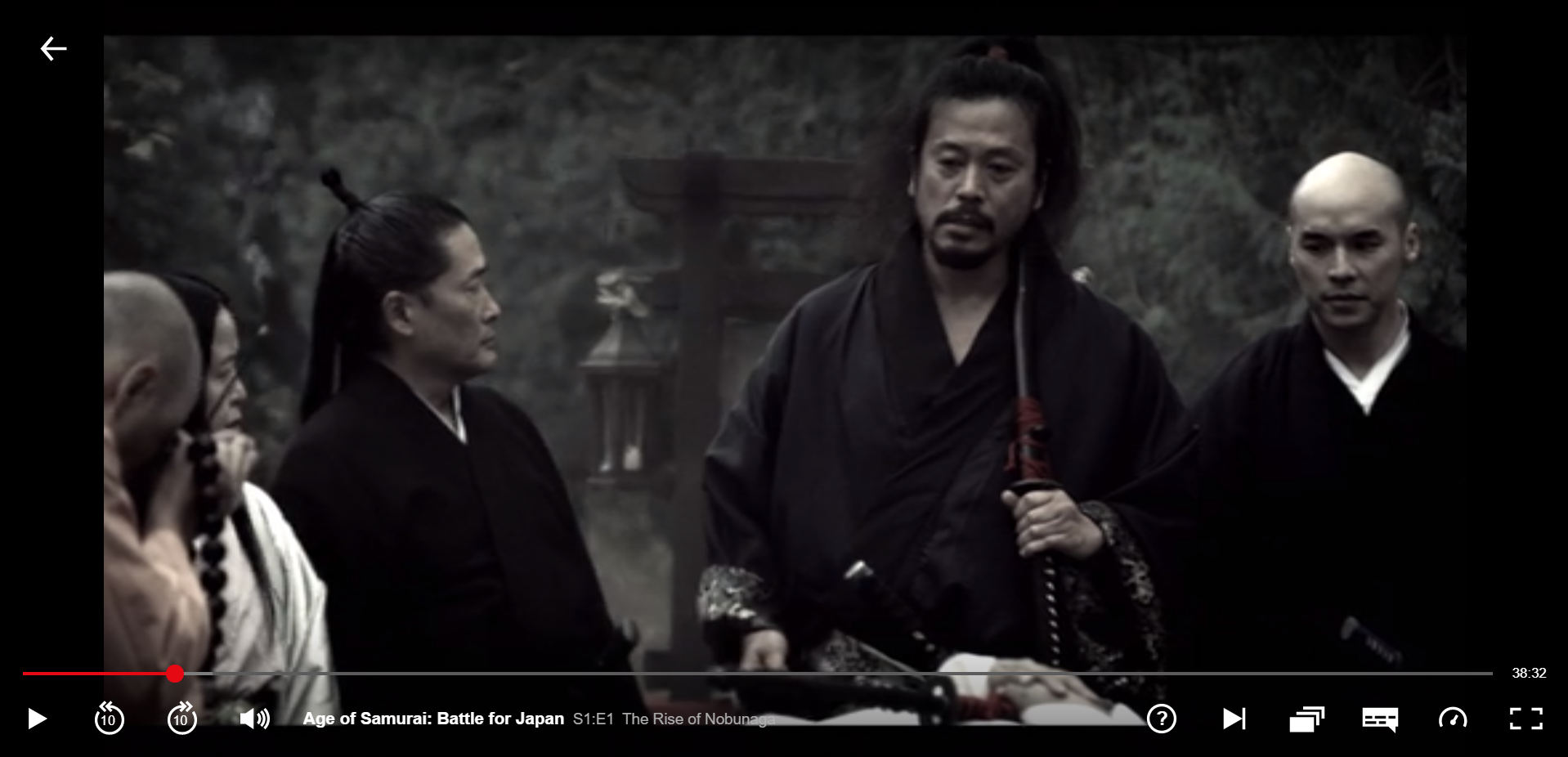 Age Of Samurai Battle for Japan Review: Does the guy with the sword look like a 17-year-old to you?
Age Of Samurai Battle for Japan Review: Does the guy with the sword look like a 17-year-old to you?The ages of these characters are ALL wrong. They depict Nobunaga as a 45 year old man, rugged hair and brooding violence in 1551-1557. In 1551 he was 17. Seventeen. And he didn’t have that hair and he didn’t have that beard. When he killed his brother in 1557 he was 25. And he was dressed correctly when he did it.
Tokugawa Ieyasu is introduced in the series around 1560. He is depicted as being in his late 30’s. In reality he was 23.
We are also introduced to a lean, bearded and rugged looking Toyotomi Hideyoshi moments before the battle of Okehazama. The actor appears to be about 45. At this time in reality, he too was just 23.
That is to say, while the actors do an excellent job, the casting department has cast middle aged men (like myself) in the roles of young strapping soldiers in their 20’s.
As an aside, I know he hasn’t shown up by this stage in the series, but Date Masamune hasn’t been born yet at the stage these events are depicted, yet when he does show up he appears to be a contemporary. In truth, He won’t be born for 7 years (1567).
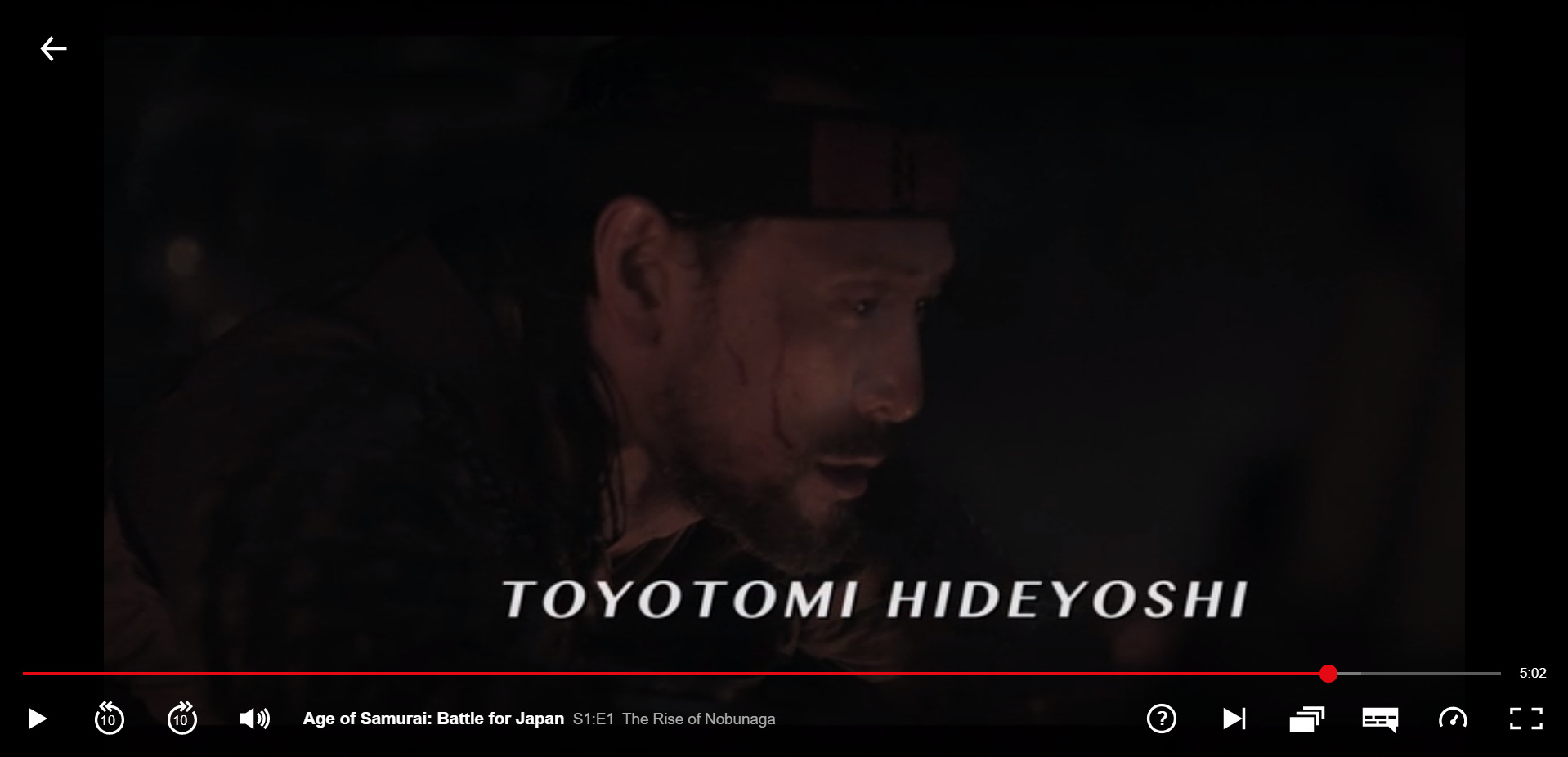 Age Of Samurai Battle for Japan Review. This is not a 23-year-old Toyotomi Hideyoshi.
Age Of Samurai Battle for Japan Review. This is not a 23-year-old Toyotomi Hideyoshi.Age Of Samurai Battle for Japan Review -
Documents
Letters are folded. They aren’t scrolls.
Age Of Samurai Battle for Japan Review -Architectural
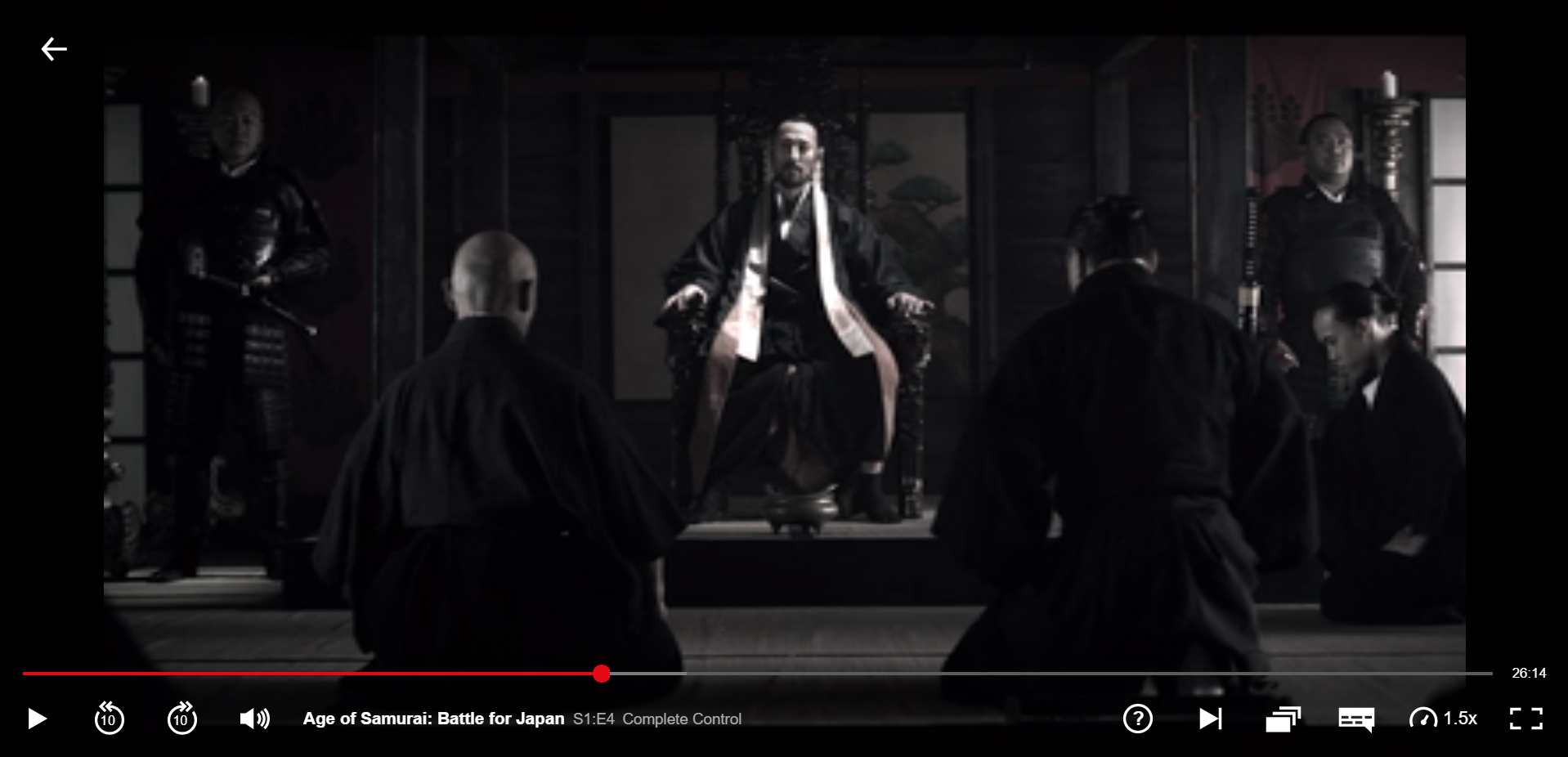 Age Of Samurai Battle for Japan Review. Hideyoshi did NOT sit on a Chinese-style throne.
Age Of Samurai Battle for Japan Review. Hideyoshi did NOT sit on a Chinese-style throne.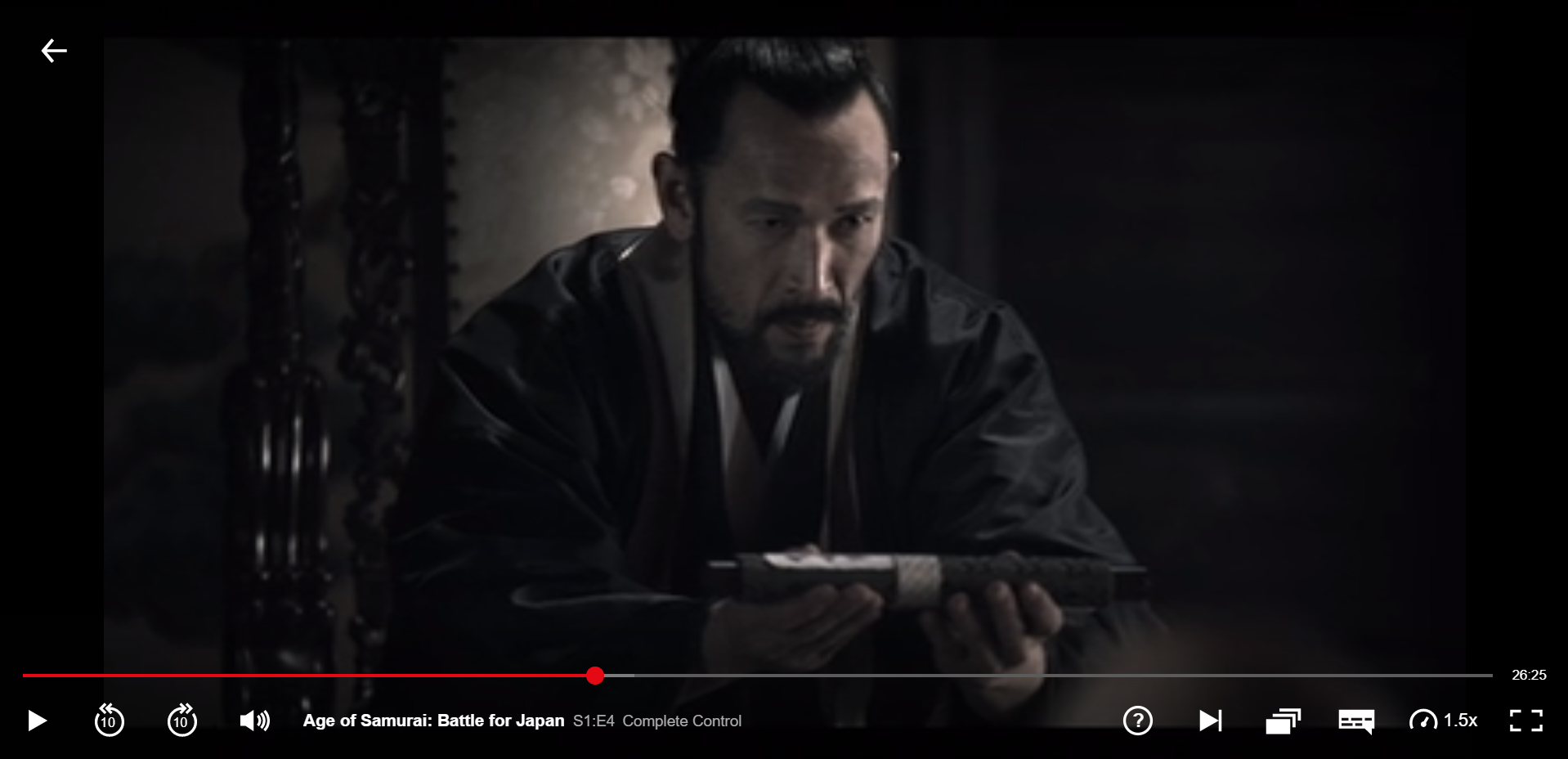 Age Of Samurai Battle for Japan Review. It's a nice chair, don't get me wrong, but that's not remotely Japanese.
Age Of Samurai Battle for Japan Review. It's a nice chair, don't get me wrong, but that's not remotely Japanese.This is all wrong. The buildings the cut scenes take place in are seemingly Chinese/Korean in nature. They are distinctly un-Japanese. The interiors are wrong with Chinese Thrones and woodwork, rather than zafuton on a raised dais of tatami. I didn’t see a single futon.
Hideyoshi’s dying moments are depicted in some type of wooden hovel. This is not Osaka Castle.
Date Masamune did not rip his eye out in a broken dirty treehouse. In fact, historical evidence shows the opposite, including a wooden image of Masamune in the temple Zuiganji, Matsushima. This image was made in 1652 at his wife Megohime's instructions and depicts his right eye, intact and present though smaller than his left. And of course there is the most compelling evidence, his body was recovered and examined in 1974, with some soft tissue still in his right orbital hollow.
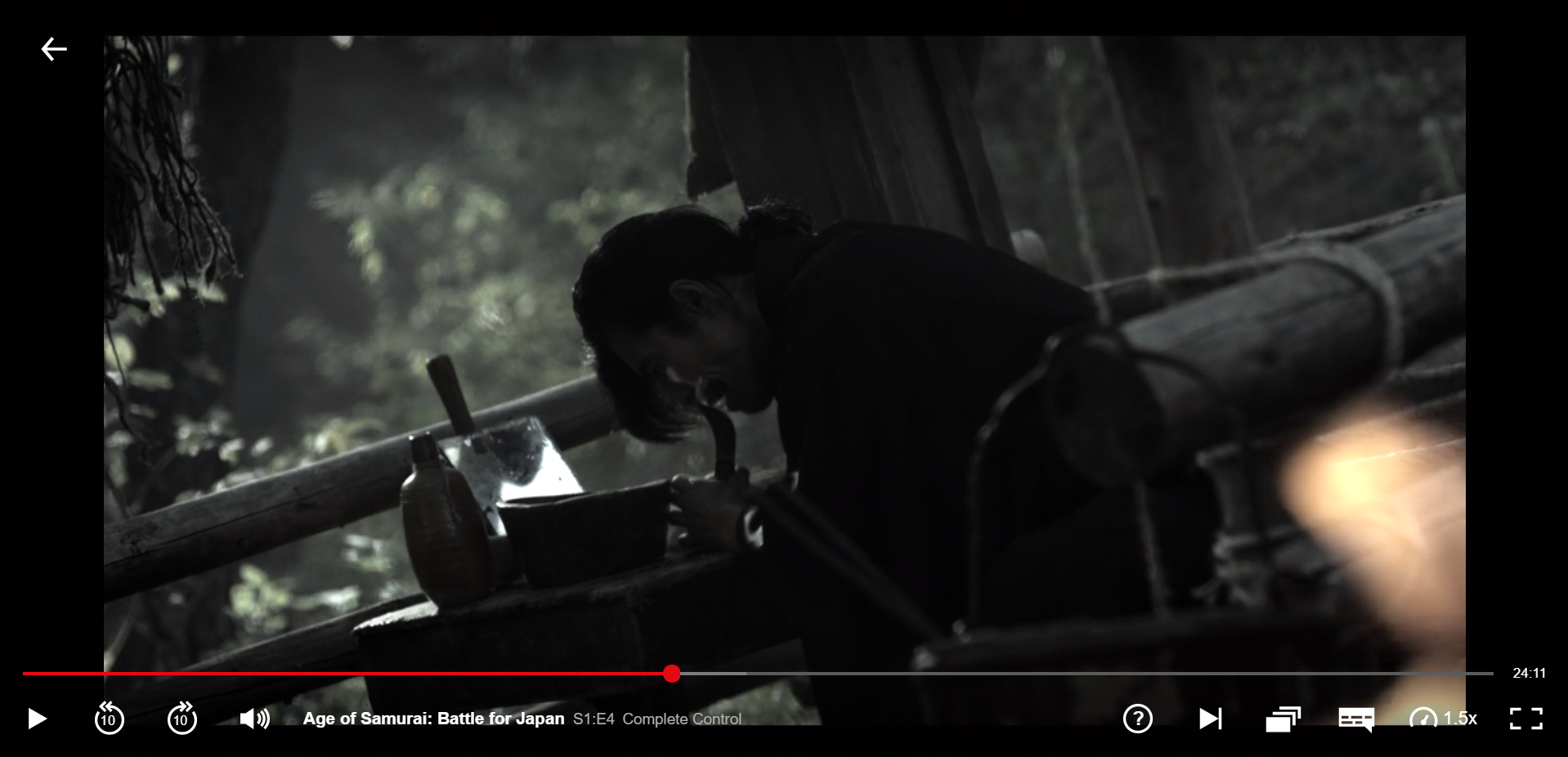 Age Of Samurai Battle for Japan Review. Date Masamune did not rip his eye out in a broken dirty treehouse
Age Of Samurai Battle for Japan Review. Date Masamune did not rip his eye out in a broken dirty treehouseAge Of Samurai Battle for Japan Review -Combative and Military Errors
Oh god, there are a LOT of errors here. Like, everything. Just everything.
Let’s start with appearance.
Age Of Samurai Battle for Japan Review -
Armour
The Armour is nearly all wrong. Armour from the wrong period. Armour made poorly. Some armour had completely alien styling, unlike anything I have seen in any culture. Leather girdles with metal studs? No. Just no. The Japanese NEVER wore armour like that. Other armours were worn incorrectly and for the most part fit badly. One samurai had his armour on backwards. Hideyoshi’s armour in several scenes had the sode (shoulder guards) on the wrong way round. We have ashigaru wearing high class samurai kabuto (helmet). That’s a no. We have commanders fighting in pitched battles without a kabuto. That’s a no.
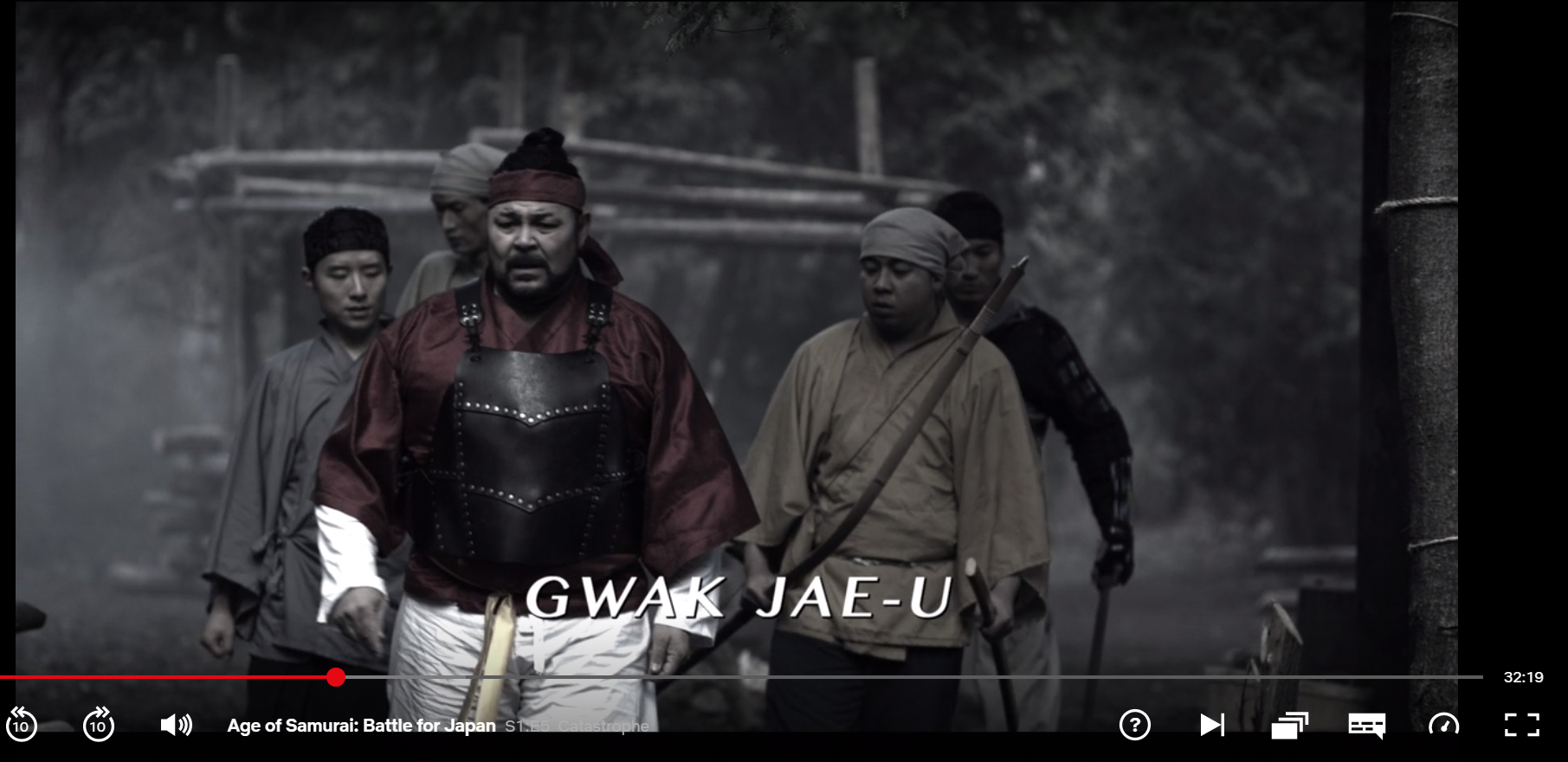 Age Of Samurai Battle for Japan Review. What is he wearing? Like, for real...what is THIS?
Age Of Samurai Battle for Japan Review. What is he wearing? Like, for real...what is THIS?The armour was inconsistent, with some factions wearing a hodgepodge of different styled armours. The trouble being those different styles represented different factions. Early episodes set between 1551-1560 show samurai fighting with Oda Nobunaga outfitted in the style of Ii Naomasa’s Red Devils. The problem of course is that he wasn’t born till March 4, 1561. And that armour style didn’t become popular until the 1590’s. around in red armour stylised to look like Ii Naomsa’s red devils. None of whom would have been fighting with Nobunaga. But red armour looks cool, and Tom Cruise wore it so who cares. And none of them had flags attached? How can you tell which side they were fighting on? How can you command the troops?
Now, I understand there will be some people that will defend this saying that there were budgetary concerns, limitations on armours etc. I get that - but I’ve been a historical consultant on low budget and independent samurai films, I know how this works.
As a historical consultant, my job was to produce a documented report providing accurate descriptions and images of the appropriate period armour, colour schemes, mon (insignia) etc. Along with providing detailed descriptions of and instruction on how that clothing was worn, what weapons were used based on that period and how they were used. The level of detail provided is immense - down to the style of tsuba, style of koshira (fittings), how the swords would be mounted, the colour of the saya, the colour of the armour braiding and tassels and so forth.
Part of my remit was to provide further detailed descriptions of the character and clan specific armour styles used, helmet and do styles, colour schemes etc and provide historical context for that. I would even recommend a variety of suppliers who could be trusted to manufacture, rent or provide such accurate equipment on a range of budgets.
That information was provided to the costume designers who did their best with the budget they had, and then it was run by me, again for a final sound off.
It is astoundingly obvious that the armour was provided by a company that doesn’t have the historical knowledge to produce accurate armour, or armour of a decent quality. I have literally seen more accurate, better designed armour made of cardboard and plaster (they literally hold parades celebrating the paper-mache armour in Japan!).
This was shameful. And it is made all the worse by the fact that we know, unequivocally what the arms and armours of the men featured in the documentary looked like. We have the armour in museums, and reproductions are readily available in any number of Japanese costume suppliers and armourers.
Age Of Samurai Battle for Japan Review -
Swords
I touched on this briefly earlier, but nearly every, if not ever sword shown in this series was of the wrong design, fittings, appearance and used utterly incorrectly.
Firstly, the swords of this period from 1550-1600 would have been tachi, a longer thinner weapon than seen in this series, or uchigatana, a kind of half breed weapon between the tachi and the katana. The key point here is that in yoroi (Japanese armour), had it been presented correctly, was hung edge down from the obi (belt) and always on the left hand side.
By contrast the producers/directors of this series instead chose to go with modern style mass produced low quality katana-like weapons. They were worn incorrectly, have the design of weapons 50-100 years before this period, were not hung or fitted correctly, and on more than one occasion slung through the obi on the right hand side. Never, ever, ever, would this have been acceptable. It is the height of ignorance and laziness on the production's behalf.
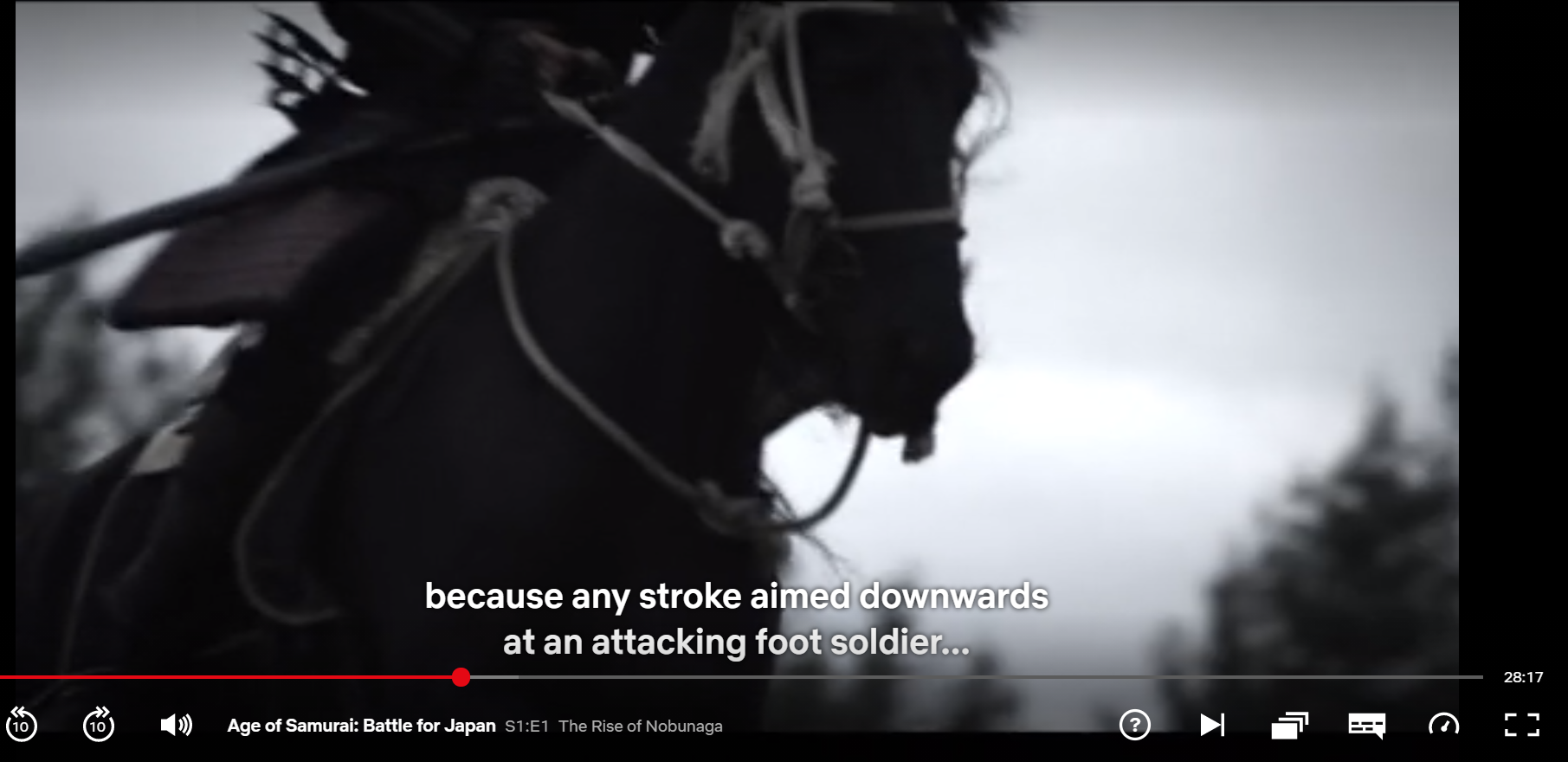 Age Of Samurai Battle for Japan Review. The swords on the wrong side mate. At least you're the only one that did this right?
Age Of Samurai Battle for Japan Review. The swords on the wrong side mate. At least you're the only one that did this right?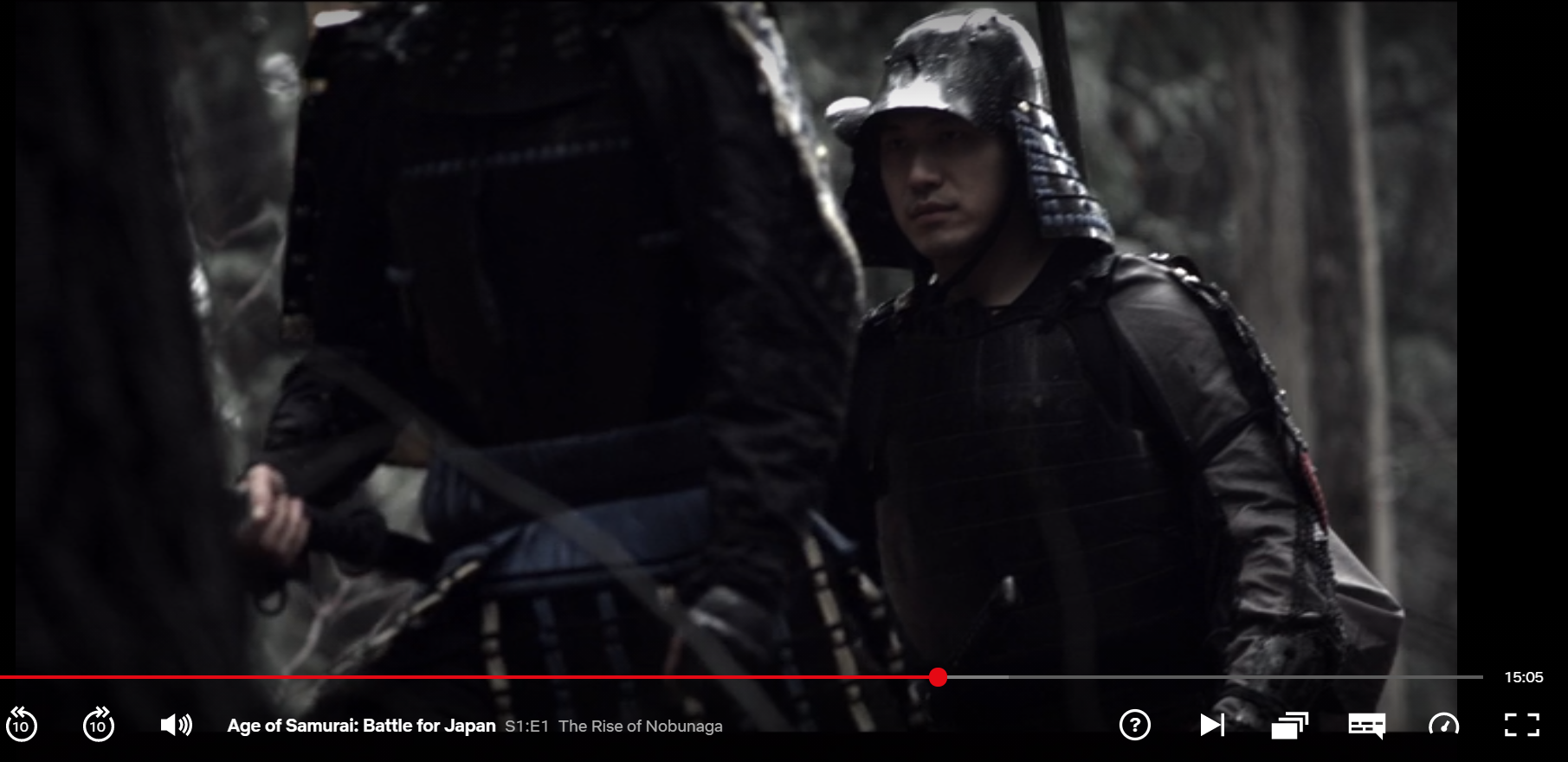 Age Of Samurai Battle for Japan Review. Wait there's another guy wearing his sword wrong? What... that's it though right? Right???
Age Of Samurai Battle for Japan Review. Wait there's another guy wearing his sword wrong? What... that's it though right? Right???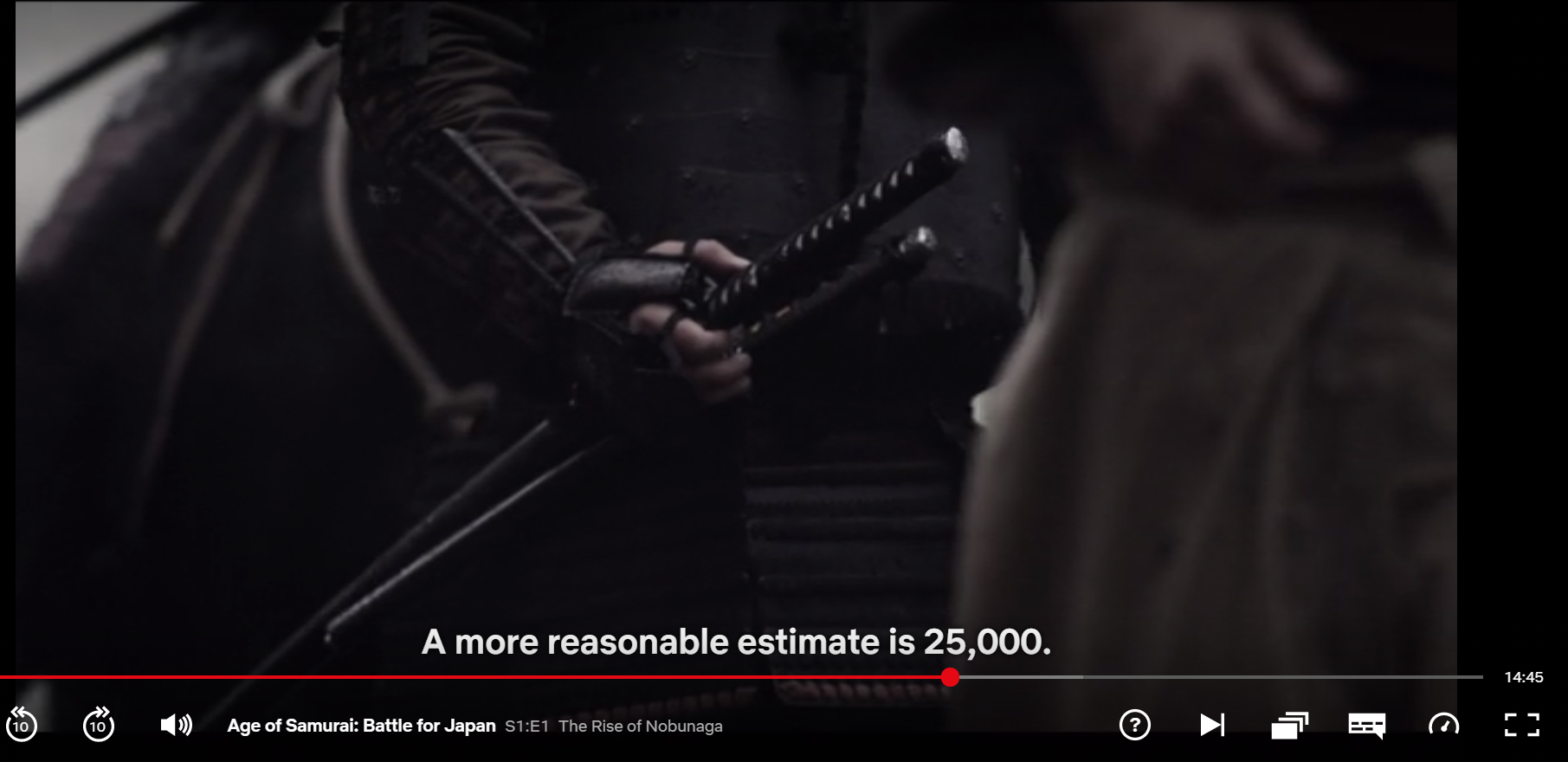 Age Of Samurai Battle for Japan Review. Why does this KEEP HAPPENING? Where are your consultants!!! Please tell me this is the last time. (Spoiler...it was not the last time...I just gave up and cried in my hands)
Age Of Samurai Battle for Japan Review. Why does this KEEP HAPPENING? Where are your consultants!!! Please tell me this is the last time. (Spoiler...it was not the last time...I just gave up and cried in my hands)Finally the usage of the swords was abysmal from start to finish. Clearly none of the actors were trained in handling or using these weapons. Note I do not hold the actors responsible, they did the best they could and in fact an admirable job in circumstances where the production severely let them down.
 Age Of Samurai Battle for Japan Review. If the edge didn't give it away, surely the curve of the blade would?
Age Of Samurai Battle for Japan Review. If the edge didn't give it away, surely the curve of the blade would?But some of these men, on more than one occasion drew their swords out (all of course with the metal SCHHHING sound - which if you know anything about Japanese swords you would know they are drawn silently) and held the sword with the cutting edge, the sharp side facing their own face. In fact they did this 20 minutes into the first episode and again 1 second later. And continued to do so throughout the 6 episodes. That is, one of the dumbest things I have ever seen.
Following this, one samurai sharpens his blade with a rock (congrats, you’ve ruined the edge and your sword), and repeatedly perform silly twirling “chiburi” - Tokugawa Iyeasu does this shortly after this character his intoduced, or worse the absurdly stupid pulling the sword through the crook of the elbow. That is PROFOUNDLY stupid. Unless you want to slice your forearm open.
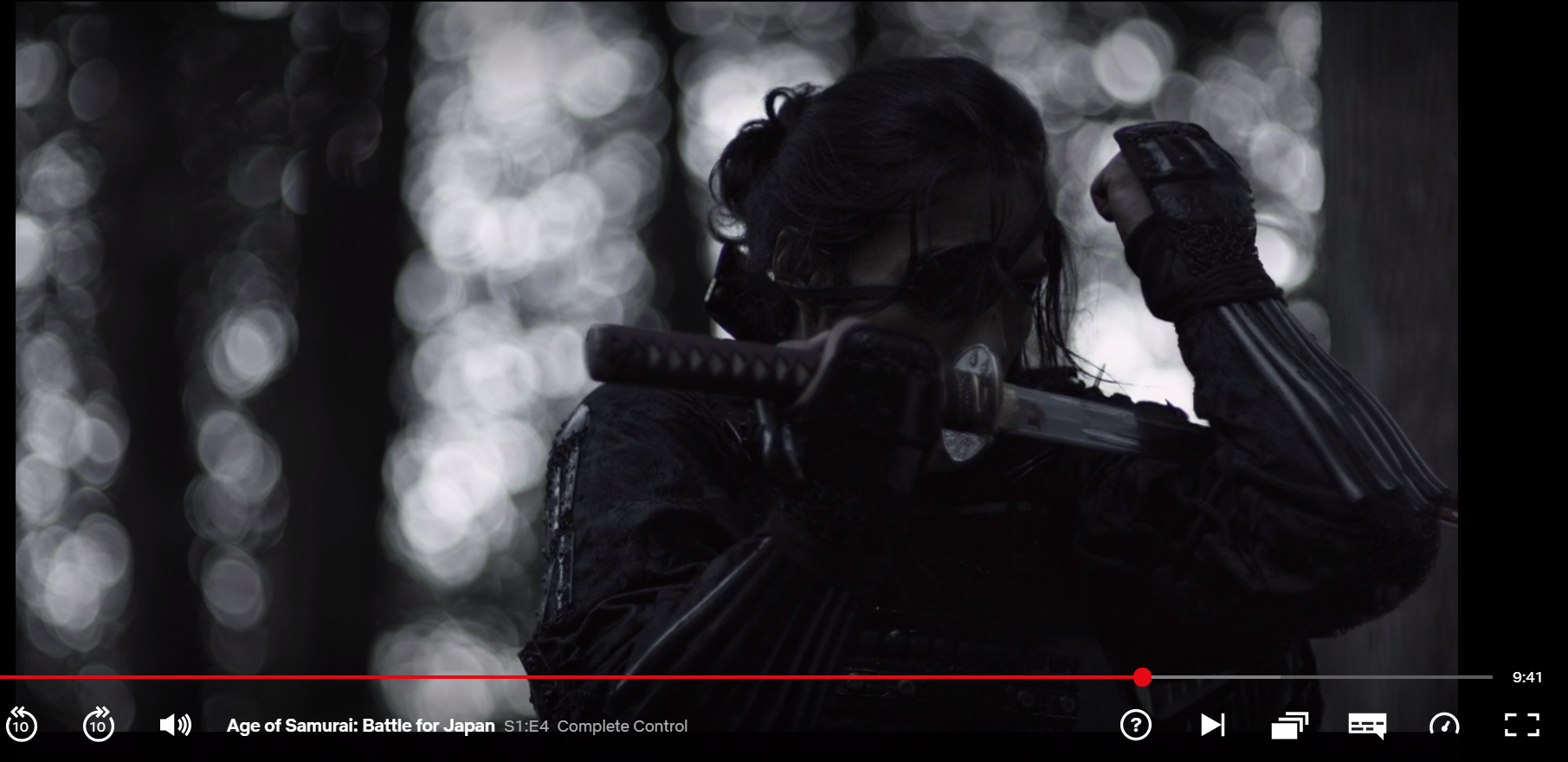 Age Of Samurai Battle for Japan Review. Date Masamune would never do something so profoundly stupid.
Age Of Samurai Battle for Japan Review. Date Masamune would never do something so profoundly stupid.Also, they repeatedly showed the swords slicing through armour like it was actually made of the cardboard it looked like. Contrary to internet memes a samurai sword cannot slice through a tank. It can’t even slice through the do and open the stomach out like shown in this series. I mean if the armour was that useless why wear it. These issues will reappear when we talk about arrows. Oh and a samurai sword cannot cut through someone’s head with the cavalier ease demonstrated so absurdly in the series. And if you are going to take someone's head you’d stand on their left hand side, not the right. Not even the slightest understanding of the ergonomics and function of these weapons is being shown. At all. Beyond stupid.
Age Of Samurai Battle for Japan Review -
Tactics
To a larger point however - the swords shouldn’t have been highlighted in the first place. There were WAY too many of them on the battlefield, all being used inappropriately. The samurai were originally mounted archers and despite changes in armour and combat styles the primary weapons of choice for samurai, including and through the period shown here remained long range weapons. There is ZERO ambiguity about this. The prominence of the sword as the weapon of the samurai began at the time this series ends.
A simple examination of the copious amounts of physical (archaeological remains) and contemporary documented accounts confirm this. For example, Dr, Karl Friday states:
"long distance weapons (arrows and rocks) accounted for about 75% of the wounds received in the pre-gun era, and about 72 % (arrows + guns + rocks) during the gunpowder era. Which is to say that "traditional fighting" does not appear to have been heavily centered on close-quarters clashes of swords or even of spears, except in literary sources".
- Dr, Karl Friday
Dr. Friday reports that in Japan, documentary evidence reporting battle wounds shows that between 1500 and 1560, out of some 620 casualties described:
- 368 were arrow wounds,
- 124 were spear wounds,
- 96 were injuries from rocks (thrown by slings or by hand),
- 18 were sword wounds,
- 7 were combined arrow and spear wounds,
- 3 were combined arrow and sword wounds,
- 2 were combined rock and spear wounds, and
- 2 were combined rock and arrow wounds.
So....let's do some basic math 478 were attributed to arrows or rocks. That's 77% of 620.
I'll be generous and remove the distance weapon-based kills if they involve a close distance weapon as well. So that comes to 466. Which is 75% of 620.
That's one period... let's look at another. Post firearms.
Between 1563 and 1600 (after guns were introduced) 584 reported casualties were reported in one batch of military records:
- 263 gunshot victims,
- 126 arrow victims,
- 99 spear victims,
- 40 sword victims,
- 30 injured by rocks, and
- 26 injured by combinations of the above (including one poor man according to Dr.Friday who was shot by both guns and arrows and stabbed by spears, and one who was speared, naginata-ed, and cut with a sword).
So math time again...263+126+30+= 445, which is 76% of 584.
It is clear "that hand- to-hand combat with bladed weapons (hakuhei-sen) did not play a pivotal role in battles" (Friday, Karl. "Handbook of premodern Japanese history"
This is also confirmed with archaeological evidence and covered comprehensively by historians and academics including:
- Fujiki Hisashi, Toyotomi heiwarei to sengoku shakai, Sengoku no sahō, Kiga to sensō sengoku ō iku, and Zōhyō-tachi no senjō;
- Fujimoto Masayuki, Sengoku kassen no jōshiki ga wakaru hon, and Nobunaga no sensō;
- Nawa Yumio, Nagashino࣭ Shitaragahara kassen no shinjitsu; Udagawa Takehisa, Teppō to sengoku kassen;
- Suzuki Masaya, Teppō to Nihonjin: “teppō shinwa” ga kakushite kita koto, Teppōtai to kiba gundan, Sengoku kassen no kyojitsu, Sentō hōkokusho ga kataru Nihon chūsei no senjō: Kamakura saimakki kara Edo shoki made.
The depiction of samurai fighting in this series is entirely unrealistic. Why all the swords? Samurai were far more likely to be killed by a rock. Where were all the rocks?
The only accurate aspect was the brief discussion of Oda Nobunaga’s revolutionary adoption of the arquebus and use of the ashigaru in mass coordination. But where were the spears and all the bowmen?
Age Of Samurai Battle for Japan Review -
Archery
And speaking of the lack of archers - the yumi (bows) and method of archery was nearly in its entirety incorrect.
Firstly the weapons are incorrect. When using yumi they are using today’s bamboo style bows, which would be a practice bow back in those days, rather than using the correct period lacquered and rattan wrapped war bows. In fact, through all 6 episodes I only spotted one white-handled Shigetoyumi that was correct (and hilariously that was used by a Korean during Hideyoshi's invasion!). Sadly, the vast majority of the bows it seems were Korean style and even some modern fiberglass,western (American) style bows!
Then we come to the usage of the bows. For the most part, it was clear, once again that no training was given to any of the actors or extra’s. And this is saddening, as a quick, even cursory examination of Japanese archery would highlight one big difference - the Japanese place the arrow on the right of the bow. Westerners place it to the left of the bow. Want to guess how the samurai drew their bow in this series...predominantly on the left side. Western style.
Also arrows seem to work like bullets for some reason in the show.
Finally...
Age Of Samurai Battle for Japan Review -
Saddles
The saddles were wrong. Mostly western stirrups, not at all like those used by the samurai with nowhere to attach items needed or acquired in war. And the riders, once again were given no training or education as they kept mounting and dismounting on the left, western style.
Age Of Samurai Battle for Japan Review -
Conclusion
I wanted to like this show. I really did. I desperately wanted there to be a high budget well made, English language and historically accurate show about the samurai so I could easily share my passion and excitement for Japanese history and the koryu martial arts I practice.
I was excited, but cautious with my optimism, hearing the repeated touting of this shows historical accuracy and how such close attention was being paid.
And there WAS a lot I liked about the show.
The Good
- I liked the actors. I thought they did a great job with the material they were given and conveyed a rough outline of the characters they were meant to embody. The fault is that of the writers and directors in repeating biased, disproven, and inaccurate interpretations of these men. But the actors themselves delivered believable performances based on what they were told to do.
- I LOVED the prominent inclusion of Nobunaga's wife Nōhime and Hideyoshi's wife Nene and concubine Yodo. These women were pivotal in the political and social development of Japan and don't get nearly enough recognition of their power and influence.
- For the most part I enjoyed the historical overview. It wasn't perfect, and was very general, but I think served to touch on the main points and highlight historical events to a new audience, who perhaps may be inspired to learn more about feudal Japanese history and the samurai.
But, there was far more I didn't like.
The Bad
- The historical interviews were largely undermined by onscreen reenactments. And the reenactments, pacing, timing and momentum were utterly stalled by the inclusion of the interviews. It was ambitious, and ultimately I don't think it worked.
- Worse still, those reenactments were utterly, inexplicably badly executed. From small issues to depicting outright lies. That was very disappointing.
- More so it had an unprecedented opportunity on a nearly never before seen worldwide platform to present a history that is already exciting and engaging without embellishment and falsification. They failed.
- They had the opportunity to present a historically accurate depiction of Japanese warfare and combat and the utterly, utterly failed.
- Instead they choose to focus on lazy tropes, lies, misinformation and undermine the history provided by the interviewees. Propagating a whole series of misconceptions to a new generation.
And the impact of that is already being seen around the world. On various discussion groups, Facebook groups, and forums, these lies are now being repeated as Gospel because they were seen on a historically-focused Netflix documentary.
I've seen this first hand myself, in a significant uptick in new member requests and emails to my dojo.
Look, I think it's great that a show, any show or film can create buzz and renewed interst in the arts I practice. I welcome that. Unfortunately, shows like Age of the Samurai: Battle for Japan make my job much harder. I have to weed out the "I want to cut peoples head off like a samurai", "I want to learn how to use the deadliest weapon ever forged", I want to be a samurai" , "teach me that cool twirly thing", "why don't we wipe the sword in our elbow" crowd, to find the sincere students.
And then I have to break their long held delusions about the samurai, and the arts I have been entrusted in part to pass on. Delusions, in part, fostered by shows like this.
This show was not evidence of how the samurai actually fought, nor was it a fair portrait of men such as Oda Nobunaga, who was not just the brute depicted, just as it was not fair to paint Akechi Mitsuhide as horrified and noble.
It would be a great move by the producers and directors to release the full interviews of the historical experts as a supplementary or "corrective" series.
I hope some good may come of it.
Age Of Samurai Battle for Japan Review -
VERDICT
Watch the interviews, watch the documentary, skip the reenactments, skip the drama. It will shorten six hours of viewing to about an hour and a half. Then research the parts that peaked your interest.
I suggest better time would be spent reading (in the following order):
- "Japan Emerging, Premodern History to 1850" edited by Karl F. Friday, IES Abroad Tokyo Center, 2012
- "Heavenly Warriors: The Evolution of Japan's Military, 500-1300" by William Wayne Farris, Council on East Asia Studies, Harvard University Press, 1992
- "Hired Swords: The Rise of Private Warrior Power in Early Japan", by Karl Friday, Stanford University Press,1996.
- Samurai, Warfare and the State in Early Medieval Japan", by Karl Friday, Rutledge Press, 2003.
- "Warriors of Japan: as Portrayed in the War Tales" by Paul Varley, University of Hawaii Press, 1994
You've been reading my Age of Samurai Battle for Japan Review. Check out the start of my Samurai History series here.
Click here to return to the Way of the Samurai Home Page.
- Home
- Samurai History
- Age Of Samurai Battle for Japan Review
Free Samurai E-books
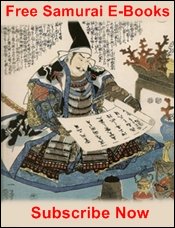
Get Free Exclusive Samurai Guides and E-books

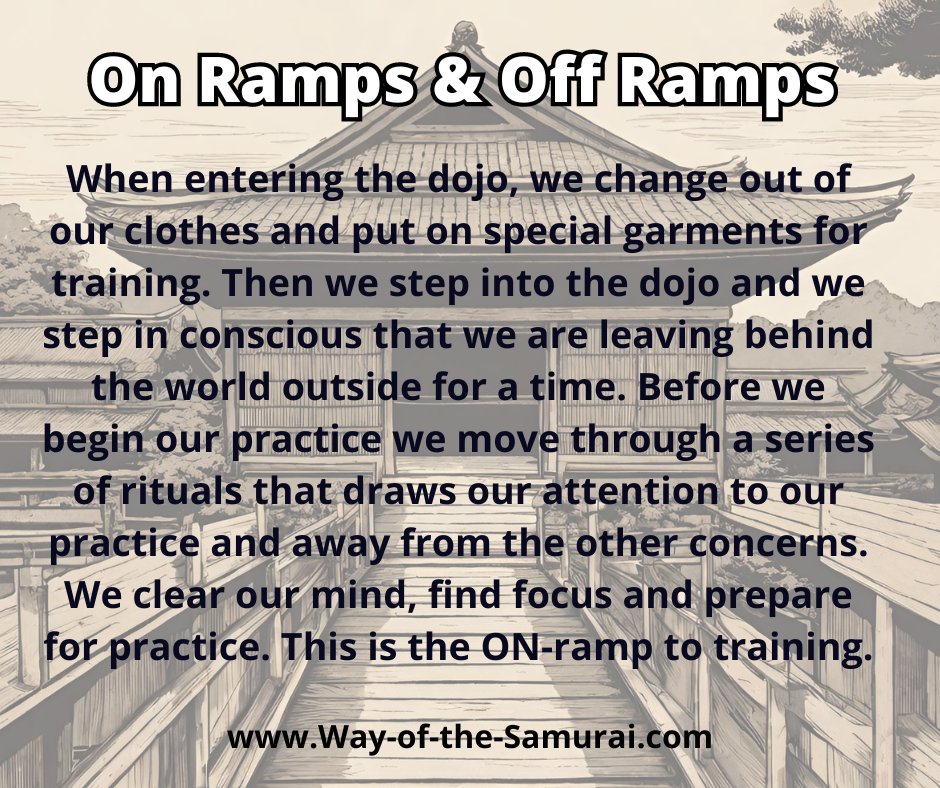
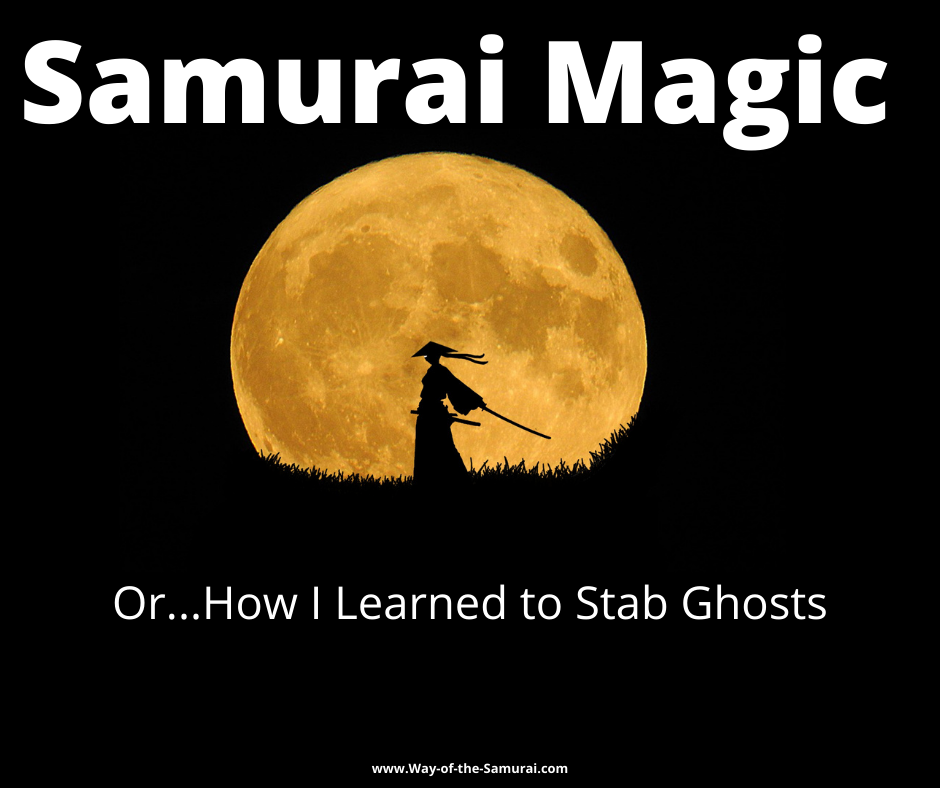
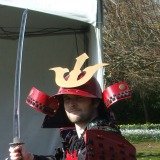




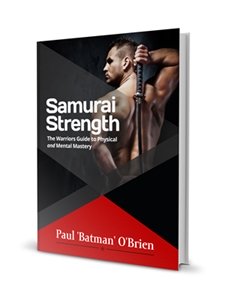
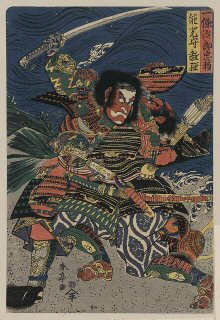
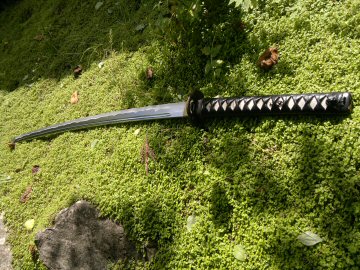
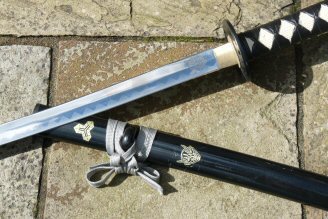
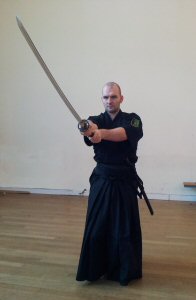
New! Comments
Have your say about what you just read! Leave me a comment in the box below.